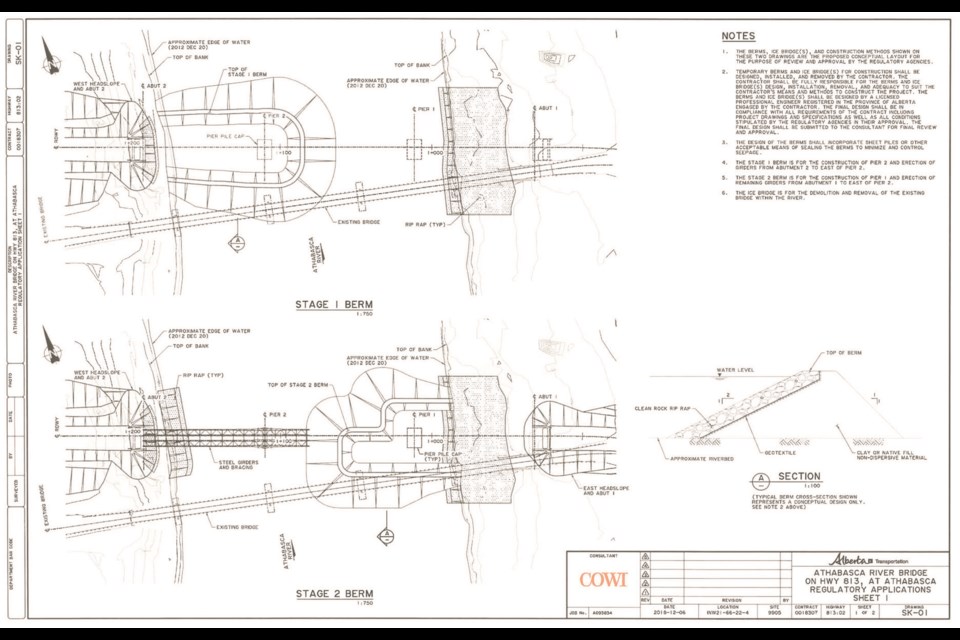ATHABASCA - The provincial government is accepting public input about the replacement of the iconic wood-deck bridge on Highway 813 crossing the Athabasca River north of the Town of Athabasca.
In a notice published Nov. 26 in the Athabasca Advocate by Alberta Transportation the open consultation phase has started after the government has completed initial environmental and stability testing as well as consultation with Indigenous groups.
Wayne Wood, communications advisor with Alberta Transportation, stated in an e-mail that Indigenous consultations took place between 2012 and 2018 for Beaver Creek Cree Nation, Heart Lake First Nation and Bigstone Cree Nation. Buffalo Lake Metis Settlement was consulted between 2017 and 2018.
“Letters were also sent out to the following six additional First Nations in 2012 as their traditional areas were within 50 km of the project,” Wood added. “Enoch Cree Nation #440, Louis Bull Tribe, Montana First Nation, Saddle Lake First Nation, Samson First Nation, and Sunchild First Nation.”
The expected start date of the project is set for Aug. 15, 2020 with completion projected to be April 1, 2022 and will include the removal of the old bridge according to the application posted on the Government of Canada website.
Athabasca Watershed Council executive director Janet Pomeroy says the group recognizes a new bridge is needed due the age and size of the present one and hopes AWC will be informed when and where the Environmental Impact Assessment (EIA) will be done.
“It is a provincial project but as it involves a water body the federal government has to be involved.” Pomeroy stated. “It is unclear where that process is by the link (to the application on the Government of Canada website).”
AWC does have concerns as berms will be put in place temporarily which will disrupt the flow of water effecting velocity of the water, spawning and foraging migration as well as users of the river, specifically small-craft river users.
“Narrowing the river will have an effect on river flow velocity which in turn may cause erosion. The narrowing of the river may cause an ice dam during spring break up and potential flooding of the town of Athabasca,” Pomeroy said. “The berms will likely produce a backwater effect, raising the normal high-water mark upstream of the berm.”
Wood did confirm there will be berms installed that will disrupt the flow temporarily and according to the application the website, “Existing obstructions include the piers of the existing Highway 813 bridge. Obstructions from the proposed project include the temporary Phase 1 Berm and the temporary Phase 2 Berm.”
“Typically, when work begins, the piers will have to be isolated from the flowing river. The water inside the isolated area will have to be removed and this is commonly referred to as dewatering,” Wood explained. “It is too early to comment on the specifics of how the isolation works will be handled as the environmental permits will specify the requirements and will have to be addressed by the successful contractor.”
The AWC’s concerns with the berms are that each will produce a strong eddy in its downstream wake.
“Sediments will accumulate in these areas and have the potential to bury fish spawning and rearing habitat,” Pomeroy said. “If this sediment is not removed before each berm is removed then it will be released rapidly upon the removal of each berm.
Isolation of half of the river at a time will produce a considerable increase in flow between the berms and the shore. How will this increase affect the ability for fish to move upstream at critical periods such as spawning and foraging migrations, especially if the berms are to be left in place over several seasons or years? Will juvenile fish be able to navigate this functional barrier?”
Wood added that materials may be thrown or deposited into the water as part of the normal construction process.
“Based on our consultant's berm review for the application to Transport Canada, it is anticipated that the materials used for the berm will be comprised of non-granular or high plastic materials such as clay and will be armoured with heavy rock,” Wood explained.
The contractor may elect to propose other methods and/or materials for the berm but would require Alberta Transporation review and may also require the review from the Department of Fish and Oceans prior to placement.”
Not only is the river important for fishing and other wildlife, it is considered to have a high volume of traffic on it as it falls in traditional hunting grounds and is a popular river for other users.
“Will this increase in river velocity affect small-craft river users – kayaks, canoes, stand up paddle boards (SUP) – or present an additional safety risk, and how will that be dealt with?” asked Pomeroy. “Also, to consider are the events like the Kapawinihk Wilderness Triathlon, Scout groups, and more.”
Wood did say that boating will be allowed subject to Transport Canada’s regulations, but access will be available.
“Permit applications are in the works,” he said. “Specific terms and conditions will be outlined in the permit issued by Transport Canada and the contractor will be required to comply.”
An article published in the Nov. 19 issue of the Athabasca Advocate stated the bridge will be wider thatn the current bridge with 10 to 11 metres allotted for lanes as well as a 2.5 metre sidewalk, for a total of 12.5 to 13.5 metres in width, pending final design.
The application can be seen online at https://cps.canada.ca/ under registry number 133 or Navigation Protection Program (NPP) file number 2019-600060.
Any concerns or comments must be in writing including the NPP file number and received no later than Dec. 26. The preferred method is e-mail to [email protected] or you can mail responses to:
Alberta Transportation
Box 4596
Barrhead, AB
T7N 1A5



